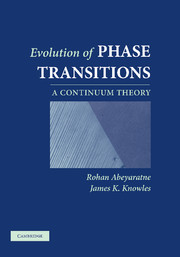1 - Introduction
Published online by Cambridge University Press: 12 August 2009
Summary
What this monograph is about
Certain crystalline materials can exist in more than one solid phase, where a phase is identified by a distinct crystal structure. Typically, one phase is preferred under certain conditions of stress and temperature, while another is favored under different conditions. As the stress or temperature varies, the material may therefore transform abruptly, from one phase to another, leading to a discontinuous change in the properties of the body. Examples of such materials include the shape-memory alloy NiTi, the ferroelectric alloy BaTiO3, the ferromagnetic alloy FeNi and the high-temperature superconducting ceramic alloy ErRh4B4. In each of these examples the transition occurs without diffusion and one speaks of the transformation as being martensitic (or displacive).
Alloys such as Au–47.5%Cd and Cu–15.3%Sn are known to have a cubic lattice at high temperatures and an orthorhombic lattice at low temperatures. Therefore, if such a material is subjected to thermal cycling, it will transform between these two phases. Similarly, alloys such as Ni–36%Al and Fe–7%Al–2%C transform between a high-temperature cubic phase and a low-temperature tetragonal phase, whereas near-equiatomic NiTi has a high-temperature cubic phase and low-temperature monoclinic phase.
If a stress-free single crystal of such a two-phase material is slowly cooled from a sufficiently high temperature, it starts out in the high-temperature phase and at first, merely undergoes a thermal contraction.
Information
- Type
- Chapter
- Information
- Evolution of Phase TransitionsA Continuum Theory, pp. 3 - 16Publisher: Cambridge University PressPrint publication year: 2006
